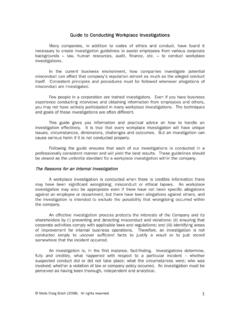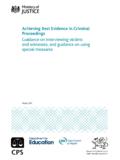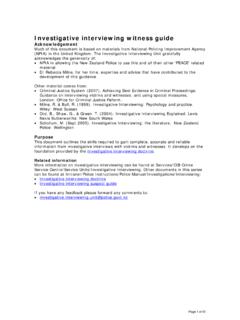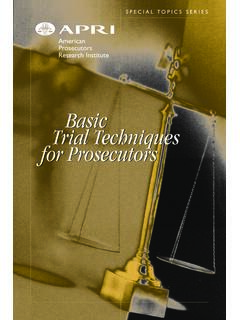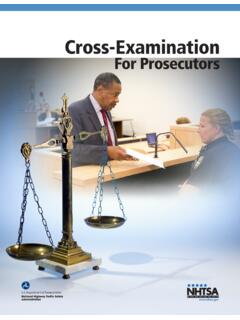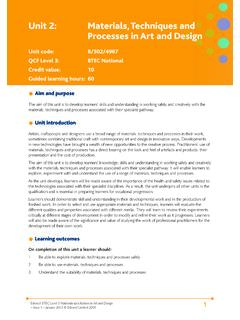Transcription of Cross-Examination Techniques 1. Introduction
1 1 Cross-Examination Techniques 1. Introduction Cross-Examination is a weapon, an effective weapon if handled correctly and a dangerous weapon if not. It can be your best friend or your worst enemy if handled incorrectly. Like a weapon, it must be treated with respect and understanding. In this lecture, I will be discussing the uses and abuses of Cross-Examination in the context of civil litigation, specifically, personal injury litigation and criminal defense, which represents my main areas of expertise. For the sake of efficiency, I will assume in this lecture that the participants have had some courtroom experience and are familiar with the main elements and features of a trial. We will begin with a discussion of the purposes of Cross-Examination and Cross-Examination in relation to other elements of the trial.
2 I will then discuss the relationship between Cross-Examination and case theory examining exactly what case theory is. I'll then go into specific Techniques of Cross-Examination and some of their foundational elements under the Federal Rules of Evidence. We will discuss motions in limine regarding the infirmities of evidence per se, the jury's response to cross - examination , building your witness ' credibility and protecting her from effective Cross-Examination by your opponent, as well as special cases in the field of Cross-Examination including the talkative and angry witness . Cross-Examination , like any other element of litigation, does not exist in a vacuum. Cross-Examination impacts and influences client preparation , case theory development, opening and final argument, pretrial motions and when relevant I will explore how these areas overlap.
3 Now, as we no doubt learned in law school Cross-Examination is probably the best tool we have to ferret out the truth in a trial. "Truth", meaning at least in terms of how far we can give credence to a person and her testimony as well as the credibility of other types of evidence. Understand that any piece of evidence could be subject to Cross-Examination . Have no fear of that. The question of the art of cross - examination arises when we decide how we will apply the paint to the canvas, in what quantity, and what proportion, and if at all. 2 2. What are the purposes of Cross-Examination ? Cross-Examination has five basic aims: to discredit the witness and thereby his theory, to discredit the witness 's theory and thereby the witness , to enhance your theory of the case, to attack the credibility of the evidence per se and fifth, to broadcast your theory of the case to the fact finder.
4 I will go into the details of these goals later on. Remember that ultimately you're aiming for a compelling closing statement, a reiteration of your theory which explains the facts better than your opponents'. In this vein, I ll be talking about one key point throughout this lecture, what is called "saving it for closing". I ll discuss some special cases related to cross as well as some dos and don ts. As far as attacking evidence per se, this does not strictly fall into the category of cross examination . But be on the lookout for hearsay, privilege, chain of custody issues, relevance, authentication, best evidence issues and the like and try to dispose of it or get it admitted in a motion in limine or in a suppression hearing. Cross-Examination is scrutiny, a close scrutiny of the reliability of the witness , and the reliability of the evidence to which he is testifying.
5 It is at the heart of a trial and functions to test the reliability and quality of evidence, much as a scientist tests his theories in a lab by trying to falsify his results. A trial is not unlike a scientific experiment testing a scientist s theory. Scientific method gathers as much evidence as it can in order to prove, or disprove, a proposition. It does this through experimentation designed to falsify the theory. At trial, attorneys are doing essentially the same thing, except we are testing opposing case theories, subjecting them to methods of falsification called cross examination and opposing argument. If the theory survives this process, we can at least hold the theory as provisionally true, depending on the burden of proof, and take appropriate action in the name of equity and fairness.
6 Of course, the burden of proof is lower in law than in science, for better or worse. Now, you cannot divorce Cross-Examination from the other aspects of the trial. A trial is a holistic enterprise. Each part depends upon the other part, symbiotically dependent on the 3 other constituent parts. Because of its centrality, learning to effectively cross -examine witnesses will help your overall trial technique immensely. For instance, a poor cross examination may strengthen your opponent's closing argument. A strong cross examination may enhance the credibility of another witness . And so on. Done right, Cross-Examination should fit in neatly and bolster your theory of the case. Information elicited during cross always must have as its objective the strengthening of your case, not information for information s sake another key difference between legal aims and scientific aims.
7 Moreover, dismiss from your mind reaching any a ha moments during cross , where you "make your case" by having a key witness breakdown on the stand. Surprisingly, that does happen, but rarely, as does the fact that a strong witness in your case in chief can simply annihilate your opponent's case. In general, it is the small points you make during trial, an accretion of equities in your favor that helps you convince a jury to see evidence in your and your client s interpretation. 3. The Personal Case and Case Theory Let's dive right in to a personal injury case for the moment to begin illustrating the development of a coherent case theory and some points about preparing for cross and protecting your witness from cross . Assume you have a client injured in a car wreck.
8 Proximate causation is a common issue. The plaintiffs attorney must have a thorough medical history of his client. During the intake make sure you get the names of all the claimants prior physicians going back at least 20 years if possible. Use your power of subpoena to procure as many records as you can. When ordering the records make sure you limit the subject matter of your demand to your theory of injury, otherwise, you will receive a mountain of records regarding your clients conditions unrelated to your case. On the other hand you must be cognizant of chronic 4 conditions which could have caused or aggravated your client s injury. And remember these records are expensive to order. When you have a thorough and exhaustive medical history of your claimant meet with her to review it.
9 Do not assume your client knows her own medical history. For that matter don't assume your client knows for a certainty the facts of her own case. Never take on face value anything your client says. It's always wise to corroborate it. This sounds harsh. But believe me it's necessary. After you have received the records create a medical record digest. Employ the following fields and formatted in a spreadsheet form. The digest should flow as follows: date of visit, providers name, symptoms presented, tests conducted and the results, diagnosis, plan of treatment, medications prescribed along with dosage, and impairment ratings, if available. After creating the medical digest give your client a copy and ask her to study it. Refresh her memory on points in her medical history that she's forgotten.
10 Especially focus on the body part that is at issue, its symptoms, and whatever treatment she has undergone in the past and present. During the deposition opposing counsel will ask your client to enumerate her visits and her having a good idea of her medical history will be an important key toward establishing her credibility. A strong, well-prepared client reflects well on her and her attorney and provides you with leverage early in the game. In personal injury law, or any other type practice for that matter, unless the claimant or plaintiff is prepared properly by his or her attorney prior to her deposition she can be a rich source of cross examination material for opposing counsel. As noted, never assume that your client knows her own medical history.
